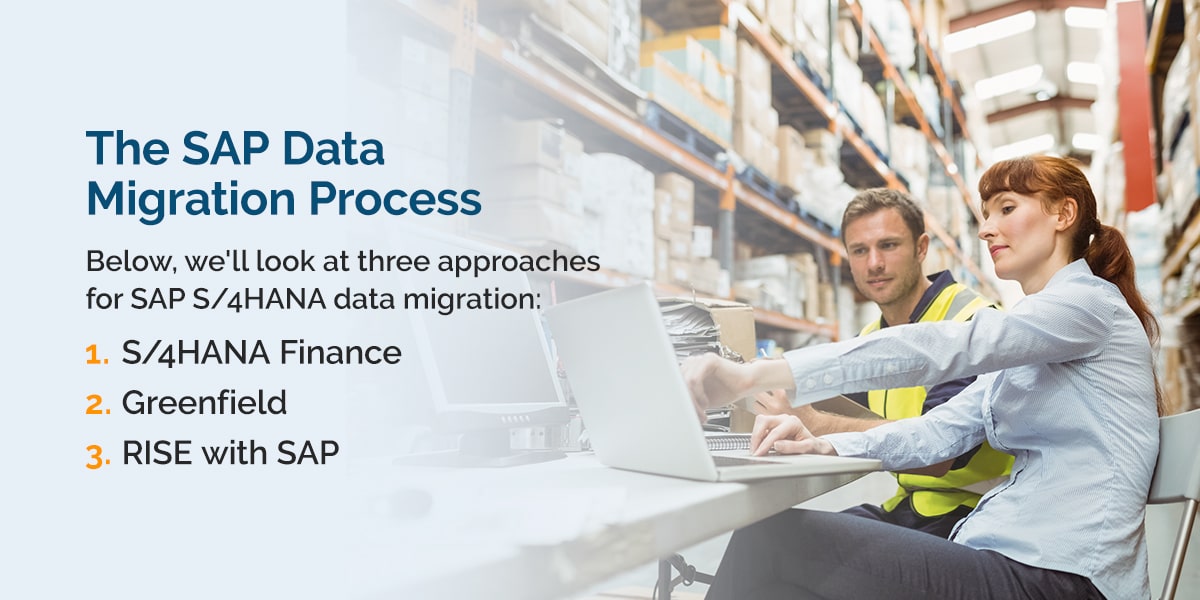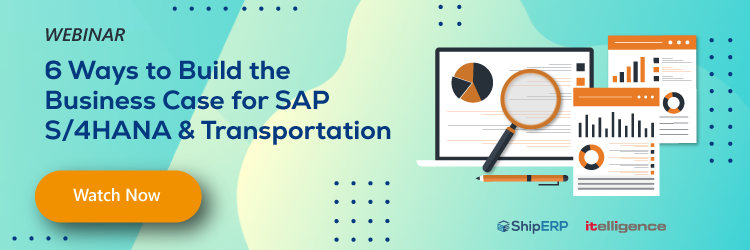
Data Migration to SAP S/4HANA
Migrating your business's data offers numerous benefits. It can:
- Improve data quality.
- Safeguard confidential information.
- Make your operations more efficient.
However, understanding and conveying the value to your business requires a more holistic understanding of the migration itself. Armed with greater knowledge of the mechanisms, you can better weigh the pros and cons of migration (and more accurately estimate the driving forces behind competitors who've already migrated). In this post, we'll cover the best tools, methods, and resources for data migration to SAP S/4HANA. Let's get started!
What Is Data Migration?
Data migration is the permanent transfer of data from one computer storage system to another. It's a key step in migrating workloads to the cloud. It also aims to ensure data accuracy, security, and integrity during the shift.
Businesses undergo data migration for numerous reasons. A company may need to:
- Consolidate different information sources after a corporate acquisition or merger.
- Upgrade their database management system and increase storage capacity.
- Remove and archive obsolete data.
- Decrease the number of data hosting systems to lower operational costs.
- Create a new data warehouse for streamlined reporting and analytics.
- Shift from a physical, on-premise storage system to a cloud computing environment.
- Upgrade existing file formats, applications, and hardware.
What Is SAP S/4HANA?
System applications and products (SAP) specializes in enterprise resource planning (ERP) software. Its solutions serve small and large businesses in numerous industries.
SAP S/4HANA stands for “SAP Business Suite 4 SAP HANA." This ERP software package allows companies to perform transactions and analyze data in real time. In turn, they can provide more efficient services for their clients and customers.
SAP S/4HANA integrates the following technologies:
- In-memory computing
- Machine learning
- Artificial intelligence (AI)
- Automation
You can deploy S/4HANA on a public, private, or hybrid cloud environment. Many organizations are switching to this solution for its advanced features and instant personalized insights. Businesses can improve their speed, productivity, flexibility, and responsiveness by employing S/4HANA.

The SAP Data Migration Process
Below, we'll look at three approaches for SAP S/4HANA data migration:
- S/4HANA Finance: Starting with the SAP S/4HANA Finance module and its integration platform — Central Finance — is a common method. This partial migration approach is a practical solution. Accounting is a back-end process that undergoes minimal change. That means you can adjust finance processes behind the scenes without disrupting your operations.
- Greenfield: With a greenfield deployment, you start from scratch. This approach involves an entirely new ERP system operating on a new cloud infrastructure or data center. Typically, a greenfield S/4HANA deployment involves shifting from an outdated SAP system or another provider's ERP. In some instances, however, a greenfield deployment may be a company's first ERP.
- RISE with SAP: RISE with SAP is part of SAP's initiative to help businesses leverage their data management processes. It provides all the benefits of ERP software. However, you can also migrate your data to the cloud without disruption or risk. RISE with SAP uses tailored ERP software. Its transformation services and business analytics make cloud migration a breeze!
SAP Data Migration Tools
What tools do you need to implement S/4HANA software into your business processes? Here are three programs you can use for SAP data migration.
1. SAP S/4HANA Data Migration Cockpit (DMC)
The DMC approach involves mapping data for the appropriate fields. You can use SAP's preset migration objects for your data transfer requirements. DMC is ideal if you've installed S/4HANA and want to migrate your data from SAP or non-SAP software systems.
2. Smart Data Integration (SDI)
SDI is an extract, transform, and load (ETL) tool. As the name suggests, it allows you to extract data from multiple source systems to S/4HANA. You can access, replicate, and transform data on-premise or in the cloud. You can then deploy prebuilt adapters to load data from different sources in real-time.
3. SAP Data Services (SDS)
SDS is an ETL tool designed to improve data migration and quality. It involves the following steps:
- Extraction: Data is extracted from various sources, including Excel, flat files, and XML. SDS can also extract from databases like DB2, Oracle, SQL Server, and S/4HANA.
- Transformation: Transformation — the most complex stage — involves standardizing data for the target system. It combines numerous data sources, aggregations, and other business processes to turn source data into target data structures.
- Validation: Validation identifies and records any data quality errors from the target side.
- Loading: The final stage involves loading the information into target systems or creating flat files.
SAP Data Migration Best Practices
If you're considering data migration to SAP S/4HANA, be sure to keep these handy tips in mind!
1. Decide How Much Data You Are Migrating
Before you can reap S/4HANA's advanced analytics, you have an important consideration. You must determine how much data you need to migrate from your current ERP. That includes configuration data, master data, and especially historical data.
Historical data is a prime component, as it helps S/4HANA be accurate and predictive. Additionally, determine how other HANA database memory requirements will increase costs.
2. Think About Your Long-Term Needs
Try to anticipate what you may need from S/4HANA in the next few years. Thinking long-term can help you avoid getting locked into an inflexible model requiring overengineered systems.
3. Set Data Migration Goals
ERP integrations can be time-consuming. They can take anywhere from a couple of months to almost two years, depending on your business size. Therefore, setting a completion timeline goal can be tricky.
SAP provides prebuilt templates, allowing you to get some parts of your company using S/4HANA in only six months. Consider setting a data migration completion goal, such as a one-year timeframe. Set data migration-centered goals for your business, as well. Some objectives might include increasing productivity, speed, and customer satisfaction.
As you begin implementing S/4HANA's features into your daily operations, gather feedback from customers. This can help you identify ways to improve your new system.
4. Determine What to Improve and Preserve
What processes do you change and keep the same? This decision largely depends on the application and the part of your company it's involved with. For instance, S/4HANA’s standard processes may best suit finance.
On the other hand, billing may require heavy customization. Changing it may cause major business disruptions.
Outline each individual process, module, and component the new S/4HANA software will impact. Use this information to determine what data to streamline or preserve.
Get in Touch With ShipERP Today
At ShipERP, we help companies integrate multi-carrier shipping into their ERP systems. This eliminates the need for a third party. We offer software as an add-on to RISE with SAP to optimize program performance.
Additionally, you can add our multi-carrier shipping software to your ERP. This system allows you to perform the following tasks:
- Rate shopping
- Order processing
- Shipment tracking
- Proof of delivery receipt from connected carriers within SAP
We've also created ShipERP Cloud, a standalone cloud-based shipping software that doesn't require SAP. With our 24/7 customer support and configurable solutions, we can help you automate common processes, reduce manual labor, and save time.
Interested in learning more about ShipERP's data management solutions? Fill out or contact form or call 562-425-7800 today!



